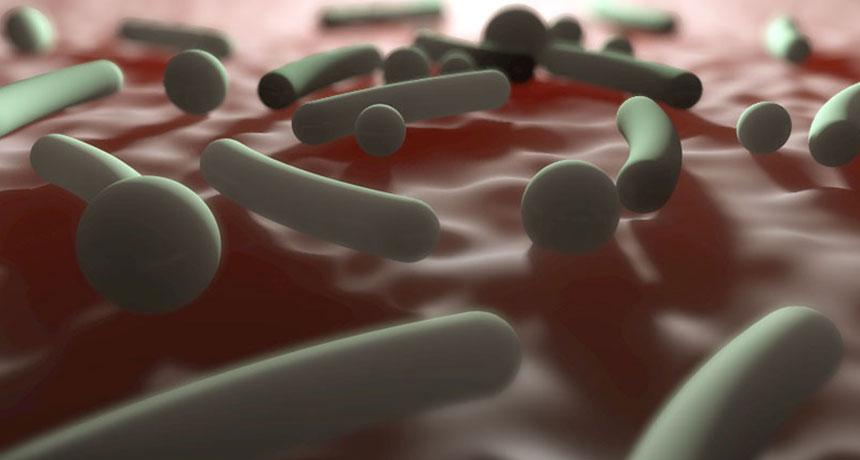How this vitamin can foster pimples
Supplement alters skin bacteria, causing inflammation, acne

Vitamin B12 can lead normal skin bacteria called Propionibacterium acnes (shown in this illustration) to pump out zits-producing chemicals.
V. ALTOUNIAN/SCIENCE TRANSLATIONAL MEDICINE
Vitamin B12 causes bacteria normally found on the skin to start pumping out chemicals that can give you zits. The new finding suggests that taking supplements of the vitamin unnecessarily can trigger acne.
Details appeared June 24 in Science Translational Medicine.
Vitamin B12 is important for making red blood cells and for brain function. The vitamin also has been known to sometimes cause acne. Dezhi Kang works at the David Geffen School of Medicine at the University of California, Los Angeles. He and his colleagues wanted to find out why the vitamin was sometimes linked to pimples. So they gave vitamin B12 supplements to 10 people with clear skin. One of them developed acne a week later.
Triggering the zits was a bacterium that normally lives on our skin. It’s called Propionibacterium acnes. Among people with pimples, some of these germs have genes that are more active than normal; other of the germ’s genes are less active. Among the less active genes are ones that these bacteria rely on to make vitamin B12.
In the new experiment, P. acnes bacteria cut back their production of vitamin B12 on their own. It turned out that the microbes were getting enough of the vitamin from those 10 human hosts. The researchers could also see that the gene activity in the bacteria was similar to P. acnes on people with zits.
In the person who developed acne, the drop in vitamin B12 production by P. acnes led to another change. The bacteria started to secrete more porphyrins (POOR-fih-rinz). These chemicals can inflame the skin. And that can lead to pimples.
(The scientists did not study whether vitamin B12 plays a role in teen acne. In puberty, hormones can lead the skin to make too much oil, called sebum. Sebum can block pores in the skin. So can dead cells and dirt. Those plugged pores are another source of pimples.)
B12 remains important to our health. Some people even have to take B12 supplements to remain healthy. So it would not be a good idea to cut foods from our diet that supply this vitamin. That would be true even if such foods did lessen the risk of developing acne.
Still, the discovery could lead to new acne treatments.
Power Words
(for more about Power Words, click here)
B12 Also known as cobalamin, it’s a vitamin that plays a role in the proper function and development of blood cells and many types of tissues. These include the brain and nerves.
bacterium (plural bacteria) A single-celled organism. These dwell nearly everywhere on Earth, from the bottom of the sea to inside animals.
chemical A substance formed from two or more atoms that unite (become bonded together) in a fixed proportion and structure. For example, water is a chemical made of two hydrogen atoms bonded to one oxygen atom. Its chemical symbol is H2O.
gene (adj. genetic) A segment of DNA that codes, or holds instructions, for producing a protein. Offspring inherit genes from their parents. Genes influence how an organism looks and behaves.
hormone (in zoology and medicine) A chemical produced in a gland and then carried in the bloodstream to another part of the body. Hormones control many important body activities, such as growth. Hormones act by triggering or regulating chemical reactions in the body. (in botany) A chemical that serves as a signaling compound that tells cells of a plant when and how to develop, or when to grow old and die.
host (in biology and medicine) The organism in which another lives. Humans may be a temporary host for food-poisoning germs or other infective agents.
inflammation (verb: to inflame) The body’s response to cellular injury and obesity; it often involves swelling, redness, heat and pain. It is also an underlying feature responsible for the development and aggravation of many diseases, especially heart disease and diabetes.
microbe Short for microorganism, a living thing that is too small to see with the unaided eye. These include bacteria, some fungi and many other organisms such as amoebas. Most consist of a single cell.
porphyrins A class of water-soluble chemicals made by plants and animals. They serve as building blocks of many important molecules, such as hemoglobin, some chlorophylls and enzymes such as catalase.
porous The description of a substance that contains tiny holes, called pores, through which a liquid or gas can pass. (in biology) The minute openings in the skin or in the outer layer of plants.
puberty A developmental period in humans and other primates when the body undergoes hormonal changes that will result in the maturation of reproductive organs.
red blood cells Colored red by hemoglobin, these cells move oxygen from the lungs to all tissues of the body.
sebum A type of oil secreted by glands (sebaceous glands) in the skin.
supplement (verb) To add to something. (in nutrition) Something taken in pill or liquid form — often a vitamin or mineral — to improve the diet. For instance, it may provide more of some nutrient that is believed to benefit health.
vitamin Any of a group of chemicals that are essential for normal growth and nutrition and are required in small quantities in the diet because they cannot be made by the body.







